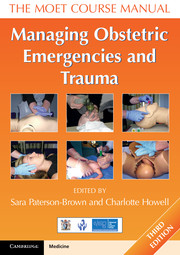Book contents
- Frontmatter
- Dedication
- Contents
- Working Group
- About the authors
- Acknowledgements
- Abbreviations
- Section 1 Introduction
- Section 2 Recognition
- Section 3 Resuscitation
- Section 4 Trauma
- 13 Introduction to trauma
- 14 Domestic abuse
- 15 Thoracic emergencies
- 16 Abdominal trauma in pregnancy
- 17 The unconscious patient
- 18 Spine and spinal cord injuries
- 19 Musculoskeletal trauma
- 20 Burns
- Section 5 Other medical and surgical emergencies
- Section 6 Obstetric emergencies
- Section 7 Triage and transfer
- Section 8 Human issues
- Index
20 - Burns
- Frontmatter
- Dedication
- Contents
- Working Group
- About the authors
- Acknowledgements
- Abbreviations
- Section 1 Introduction
- Section 2 Recognition
- Section 3 Resuscitation
- Section 4 Trauma
- 13 Introduction to trauma
- 14 Domestic abuse
- 15 Thoracic emergencies
- 16 Abdominal trauma in pregnancy
- 17 The unconscious patient
- 18 Spine and spinal cord injuries
- 19 Musculoskeletal trauma
- 20 Burns
- Section 5 Other medical and surgical emergencies
- Section 6 Obstetric emergencies
- Section 7 Triage and transfer
- Section 8 Human issues
- Index
Summary
Objectives
On successfully completing this topic, you will be able to:
understand the impact of a thermal injury on the airway, breathing and circulation
describe the immediate management of airway breathing and circulation in a patient with burns
assess the severity of burns
discuss the management of the fetus in the pregnant patient with burns.
Introduction
The incidence of pregnancy in women admitted to hospital with burn injuries has been found to be 6.8–7.8%. The burned pregnant woman should be managed jointly by the burns team and obstetricians. This may necessitate transfer to a burns centre with appropriate transfer of care to a local obstetrician. Most burns are caused by thermal injury but chemical, electrical and radiation burns also occur.
The severity of the injury is chacterised by the area and depth of the burn and the effect on the vital functions (the ‘ABCs’). Burns may cause immediately life-threatening problems that need to be identified and simultaneously treated in the primary survey. A surface area burn of 25–50% has a mortality rate of 63% for both mother and fetus.
Pathophysiology of burns
Airway obstruction
Airway burns may result in airway obstruction due to oedema as a direct response to thermal injury (heat). Obstruction of the lower airways may be caused by deposition of soot particles. Airway injury from burns can be immediate or delayed, so the airway must be continually observed and early intubation should be considered, particularly if the patient is to be transferred. The maximum oedema is likely to occur at 24 hours after injury, but changes in airway patency can be rapid and disastrous. Clinical changes of impending airway obstruction will be seen, i.e. stridor, increased work of breathing with falling SaO2 and decreasing conscious level. Stridor is therefore a ‘red flag’ symptom in the context of burn injury.
- Type
- Chapter
- Information
- Managing Obstetric Emergencies and TraumaThe MOET Course Manual, pp. 221 - 226Publisher: Cambridge University PressPrint publication year: 2014

